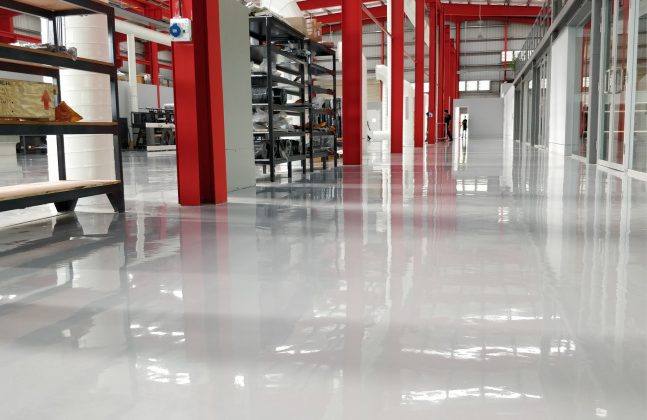Not so many moons ago, it was feared that the growth of the digital age was set to wipe out print media altogether thanks to the rise of online newspapers, blogs (ahem) and digital magazines.
However it was clear to see in 2018 that the industry is growing, adapting and strengthening its presence within a digital world. In India for example, technological advancements including UV digital printing and inkjet technology has resulted in the printing industry growing at a rapid rate of 12% per annum!
Printing companies within India are equipped with the latest computer controlled printing machines and flow lines for binding, while state-of-the-art technologies are used in prepress.
As with any industry, where there is growth there are often challenges to meet. These challenges can range from meeting client demand to maintaining high health and safety standards.
At a base level, all areas within a printing facility must be safe and functional in order to facilitate workflow, and here the construction of the facility itself can help.
Challenge: Chemicals
The layout of a printing plant should enable the smooth flow of production from prepress operations such as artwork preparation and plate making to the multicolour printing with online, error-free numbering and post printing operations of binding, pinning, cutting, packing and dispatch.
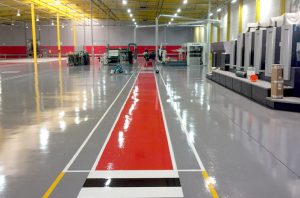
Chemicals are inherent in printing facilities, from airborne solvent vapours from printing chemicals, to the strong chemical cleaners needed to clean the printing machinery. Daily exposure to such chemicals can be very harmful to staff members and can also cause long-term damage to the facility itself.
With such a particular workflow, the floors can be exposed to hazardous waste such as photographic and residual chemicals, metal hydroxide sludge, dyestuff and solvent residues, wiping materials containing dyes and solvents and even oil spills.
The Solution: Chemical Resistance
The flooring in such facilities can benefit from additional properties such as stain resistance, chemical resistance and slip resistance. Whilst stains do not affect the functionality of flooring, added stain resistance leaves the floor looking its best for longer.
Prolonged exposure to chemicals however can damage the floor’s surface, and can lead to peeling or cracks forming. If the flooring becomes worn to this level, it can be just as dangerous as having a lack of slip resistance, as staff could trip on a cracked floor and fall, leading to accidents and in extreme cases, litigation.
Expensive repairs could also be on the cards for facilities that ignore a peeling surface, as chemical erosion of the substrate can jeopardise the structural integrity of the building, leading to costly repairs and a new floor coating.
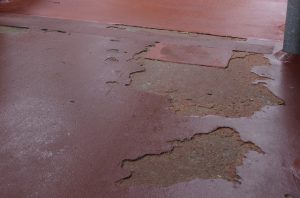
Chemical resistance is not the only major consideration for printing facilities however.
The Problem: Static Charge
Static electricity is used to control the movement of paper in laser printers. The core component of this system is the photoreceptor, which is typically a revolving cylinder or drum that moves the paper along. This drum assembly is made out of highly photoconductive material that is discharged by light protons. The static keeps the paper ‘stuck’ to the drum so that the print is issued in the correct position.
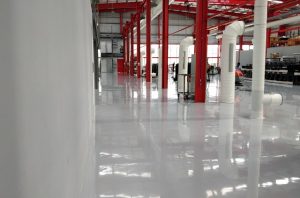
Static electricity can be a key concern within this industry, as it can cause printing defects, thanks to the static pushing and pulling ink particles away from their intended trajectories, and can even cause press operators static shocks.
The Solution: Antistatic Flooring
Antistatic flooring is the mandated flooring requirement for these areas. In order to dissipate static charge, antistatic flooring is able to assist in preventing electrical charges affecting sensitive printing technology or causing an ignition source around solvents, by safely dissipating the charge across its surface and to ground.
In order to ground the antistatic charge, copper grids or rods can be used to quickly transfer the charge from the floor’s surface to a safe earth. Earthing rods must be installed by a qualified electrician and tested to ensure that the charge is being earthed as quickly as possible.

Static charge can easily be generated by staff walking across the floor’s surface, but when walking on an ESD flooring system, the charge is dissipated with each footstep. This charge reaches the conductive floor and, depending on the build-up of the flooring system, moves through the surface via special conductive fibres, then flows through carbon coated aggregates and an ESD primer before finally transferring to an appropriate earth point.
Less Challenging Areas
For other areas of the printing facility that do not require anti-static properties, a chemical resistant epoxy resin floor finish is a great choice.
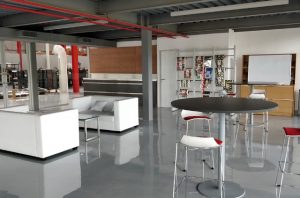
Typically used in dry process areas, including laboratories, clean rooms and warehouses where pallet trucks and rubber wheeled forklift traffic are likely, this is a highly durable floor finish that is abrasion and chemical resistant, and more than capable of withstanding the challenges faced in printing facilities.
To find out more about chemical resistant and antistatic flooring solutions, leave a comment below or give us a call, we’d be happy to help!

